Cost-Effective and Energy-Efficient Photonics-Based Frequency Hopping by Single Wavelength-Tunable Laser for Secure THz Communication
Abstract
:1. Introduction
2. THz Frequency Hopping Using a Single Tunable Laser
3. Reflection-Type Transversal Filter Laser
4. Experiments for Generating Frequency-Hopped THz Wave by a Single TL
4.1. Demonstration of Switching Among Four Frequencies in the RTF Laser
4.2. Demonstration of Frequency Hopping Among Three Frequencies in the 300-GHz Band
5. Discussion
6. Conclusions
Author Contributions
Funding
Institutional Review Board Statement
Informed Consent Statement
Data Availability Statement
Conflicts of Interest
References
- Wang, S.; Zhang, X.; Zhang, Y.; Wang, L.; Yang, J.; Wang, W. A Survey on Mobile Edge Networks: Convergence of Computing, Caching and Communications. IEEE Access 2017, 5, 6757–6779. [Google Scholar] [CrossRef]
- Adebusola, J.A.; Ariyo, A.A.; Elisha, O.A.; Olubunmi, A.M.; Julius, O.O. An Overview of 5G Technology. In Proceedings of the 2020 International Conference in Mathematics, Computer Engineering and Computer Science (ICMCECS), Ayobo, Nigeria, 18–21 March 2020. [Google Scholar] [CrossRef]
- Ahmed, S.F.; Alam, M.S.B.; Afrin, S.; Rafa, S.J.; Taher, S.B.; Kabir, M.; Muyeen, S.M.; Gandomi, A.H. Toward a Secure 5G-Enabled Internet of Things: A Survey on Requirements, Privacy, Security, Challenges, and Opportunities. IEEE Access 2024, 12, 13125–13145. [Google Scholar] [CrossRef]
- Alhammadi, A.; Al-Alawi, R.M.; Jahdhami, M.A.A.; El-Saleh, A.A.; Ismail, Z.H.; Shamsan, Z.A.; Shayea, I. Revolutionizing Mobile Broadband: Assessing Multicellular Networks in Indoor and Outdoor Environments. IEEE Access 2024, 12, 120840–120863. [Google Scholar] [CrossRef]
- Song, H.J.; Nagatsuma, T. Present and Future of Terahertz Communications. IEEE Trans. Terahertz Sci. Technol. 2015, 1, 256–263. [Google Scholar] [CrossRef]
- Nagatsuma, T.; Horiguchi, S.; Minamikata, Y.; Yoshimizu, Y.; Hisatake, S.; Kuwano, S.; Yoshimoto, N.; Terada, J.; Takahashi, H. Terahertz wireless communications based on photonics technologies. Opt. Express 2013, 21, 23736–23747. [Google Scholar] [CrossRef] [PubMed]
- Nagatsuma, T.; Carpintero, G. Recent Progress and Future Prospect of Photonics-Enabled Terahertz Communications Research. IEICE Trans. Electron. 2015, E98-C, 1060–1070. [Google Scholar] [CrossRef]
- Akyildiz, I.F.; Han, C.; Hu, Z.; Nie, S.; Jornet, J.M. Terahertz Band Communication: An Old Problem Revisited and Research Directions for the Next Decade. IEEE Trans. Commun. 2022, 70, 4250–4285. [Google Scholar] [CrossRef]
- Seeds, A.J.; Shams, H.; Fice, M.J.; Renaud, C.C. TeraHertz Photonics for Wireless Communications. J. Light. Technol. 2015, 33, 579–587. [Google Scholar] [CrossRef]
- Elayan, H.; Amin, O.; Shihada, B.; Shubair, R.M.; Alouini, M.S. Terahertz Band: The Last Piece of RF Spectrum Puzzle for Communication Systems. IEEE Open J. Commun. Soc. 2019, 1, 1–32. [Google Scholar] [CrossRef]
- Huq, K.M.S.; Busari, S.A.; Rodriguez, J.; Frascolla, V.; Bazzi, W.; Sicker, D.C. Terahertz-Enabled Wireless System for Beyond-5G Ultra-Fast Networks: A Brief Survey. IEEE Netw. 2019, 33, 89–95. [Google Scholar] [CrossRef]
- Yu, X.; Chen, Y.; Galili, M.; Morioka, T.; Jepsen, P.U.; Oxenløwe, L.K. The prospects of ultra-broadband THz wireless communications. In Proceedings of the 2014 16th International Conference on Transparent Optical Networks (ICTON), Graz, Austria, 6–10 July 2014. [Google Scholar] [CrossRef]
- Zhang, H.; Zhang, L.; Yu, X. Terahertz band: Lighting up next-generation wireless communications. China Commun. 2021, 18, 153–174. [Google Scholar] [CrossRef]
- Zhang, H.; Yang, Z.; Lyu, Z.; Yang, H.; Zhang, L.; Ozolins, O. 300 GHz photonic-wireless transmission with aggregated 1.034 Tbit/s data rate over 100 m wireless distance. In Proceedings of the 2024 Optical Fiber Communications Conference and Exhibition (OFC), San Diego, CA, USA, 24–28 March 2024. [Google Scholar] [CrossRef]
- Maekawa, K.; Yoshioka, T.; Nakashita, T.; Ohara, T.; Nagatsuma, T. Single-carrier 220-Gbit/s sub-THz wireless transmission over 214 m using a photonics-based system. Opt. Lett. 2024, 49, 4666–4668. [Google Scholar] [CrossRef]
- Nguyen, V.L.; Lin, P.C.; Cheng, B.C.; Hwang, R.H.; Lin, Y.D. Security and Privacy for 6G: A Survey on Prospective Technologies and Challenges. IEEE Commun. Surv. Tutor. 2021, 23, 2384–2428. [Google Scholar] [CrossRef]
- Shrestha, R.; Guerboukha, H.; Fang, Z.; Knightly, E.; Mittleman, D.M. Jamming a terahertz wireless link. Nat. Commun. 2022, 13, 3045. [Google Scholar] [CrossRef]
- Ma, J.; Shrestha, R.; Adelberg, J.; Yeh, C.Y.; Hossain, Z.; Knightly, E.; Journet, J.M.; Mittleman, D.M. Security and eavesdropping in terahertz wireless links. Nature 2018, 563, 89–93. [Google Scholar] [CrossRef] [PubMed]
- Li, P.; Wang, J.; Zhao, L.; Gao, X.; Song, F.; Sun, H.; Ma, J. Scattering and Eavesdropping in Terahertz Wireless Link by Wavy Surfaces. IEEE Trans. Antennas Propag. 2023, 71, 3590–3597. [Google Scholar] [CrossRef]
- Mucchi, L.; Jayousi, S.; Caputo, S.; Panayirci, E.; Shahabuddin, S.; Bechtold, J.; Morales, I.; Stoica, R.A.; Abreu, G.; Haas, H. Physical-Layer Security in 6G Networks. IEEE Open J. Commun. Soc. 2021, 2, 1901–1914. [Google Scholar] [CrossRef]
- Wang, N.; Wang, P.; Fanid, A.A.; Jiao, L.; Zeng, K. Physical-Layer Security of 5G Wireless Networks for IoT: Challenges and Opportunities. IEEE Internet Things J. 2019, 6, 8169–8181. [Google Scholar] [CrossRef]
- Chen, W.; Chen, Z.; Ma, X.; Chi, Y.; Li, Z. Secrecy rate optimization for intelligent reflecting surface aided multi-input-single-output terahertz communication. Microw. Opt. Technol. Lett. 2020, 62, 2760–2765. [Google Scholar] [CrossRef]
- Zhu, Y.; Mao, B.; Kato, N. Intelligent Reflecting Surface in 6G Vehicular Communications: A Survey. IEEE Open J. Veh. Technol. 2022, 3, 266–274. [Google Scholar] [CrossRef]
- Qiao, J.; Zhang, C.; Dong, A.; Bian, J.; Alouini, M.S. Securing Intelligent Reflecting Surface Assisted Terahertz Systems. IEEE Trans. Veh. Technol. 2022, 71, 8519–8533. [Google Scholar] [CrossRef]
- Zhang, L.; Deng, Q.; Zhang, H.; Yang, Z.; Pang, X.; Bobrovs, V.; Popov, S.; Wu, Y.; Yu, X.; Ozolins, O.; et al. Quantum Noise Secured Terahertz Communications. IEEE J. Sel. Top. Quantum Electron. 2022, 29, 8400110. [Google Scholar] [CrossRef]
- Kato, K. Photonics-Assisted Terahertz-Wave Beam Steering and Its Application in Secured Wireless Communication. Photonics 2022, 9, 9. [Google Scholar] [CrossRef]
- Liu, Y.; Yang, F.; Yang, Z.; Zhang, L.; Jiang, H.; Chen, F.; Li, M.; Zhang, Z.; Liu, Y.; Zhang, J. Full W-band Photonic Frequency Hopping Generator Based on High-order Optical Frequency Multiplication. In Proceedings of the 2023 International Topical Meeting on Microwave Photonics (MWP), Nanjing, China, 15–18 October 2023. [Google Scholar] [CrossRef]
- Yang, Z.; Yang, F.; Wen, Z.; Wang, H.; Liu, Y.; Jiang, H.; Chen, F.; Liu, Y.; Li, M.; Zhang, J. Ultra-Wideband Photonic Frequency-Hopping Waveform Generator Enabled by Optical Injection Locking for Secure Terahertz Wireless Communications. J. Light. Technol. 2024, 42, 6788–6797. [Google Scholar] [CrossRef]
- Li, Z.; Chen, J.; Tang, D.; Zhou, R.; Hong, W. A 205–273-GHz Frequency Multiplier Chain (×6) with 9-dBm Output Power and 1.92% DC-to-RF Efficiency in 0.13-µm SiGe BiCMOS. IEEE Trans. Microw. Theory Tech. 2023, 71, 2909–2919. [Google Scholar] [CrossRef]
- Nallappan, K.; Skorobogatiy, M. Photonics based frequency hopping spread spectrum system for secure terahertz communications. Opt. Express 2022, 30, 27028–27047. [Google Scholar] [CrossRef]
- Li, B.; Ye, S.; Che, M.; Tang, H.; Masutomi, N.; Mikami, Y.; Kato, K. Demonstration of THz Frequency Hopping in the 300 GHz Band Based on UTC-PD and Tunable DFB Laser Array. Jpn. J. Appl. Phys. 2024, 63, 04SP86. [Google Scholar] [CrossRef]
- Ye, S.; Masutomi, N.; Li, B.; Matsumoto, R.; Kaide, R.; Tang, H.; Kamiura, Y.; Che, M.; Mikami, Y.; Ueda, Y.; et al. Photonic Frequency Hopping Driven by High-Speed Wavelength Tunable Laser for Secure Terahertz-wave Communication. In Proceedings of the 2024 Optical Fiber Communications Conference and Exhibition (OFC), San Diego, CA, USA, 24–28 March 2024. [Google Scholar] [CrossRef]
- Shiramizu, T.; Seiki, N.; Matsumoto, R.; Masutomi, N.; Mikami, Y.; Ueda, Y.; Kato, K. Feasibility Demonstration of THz Wave Generation/Modulation Based on Photomixing Using a Single Wavelength-Tunable Laser. Photonics 2023, 10, 369. [Google Scholar] [CrossRef]
- Ueda, Y.; Saito, Y.; Shindo, T.; Kanazawa, S.; Kobayashi, W.; Matsuzaki, H.; Ishikawa, M. Hitless Wavelength Switching of Semiconductor Optical Amplifier-Integrated Reflection-Type Transversal Filter Laser with Suppressed Frequency Error. J. Light. Technol. 2023, 41, 2765–2774. [Google Scholar] [CrossRef]
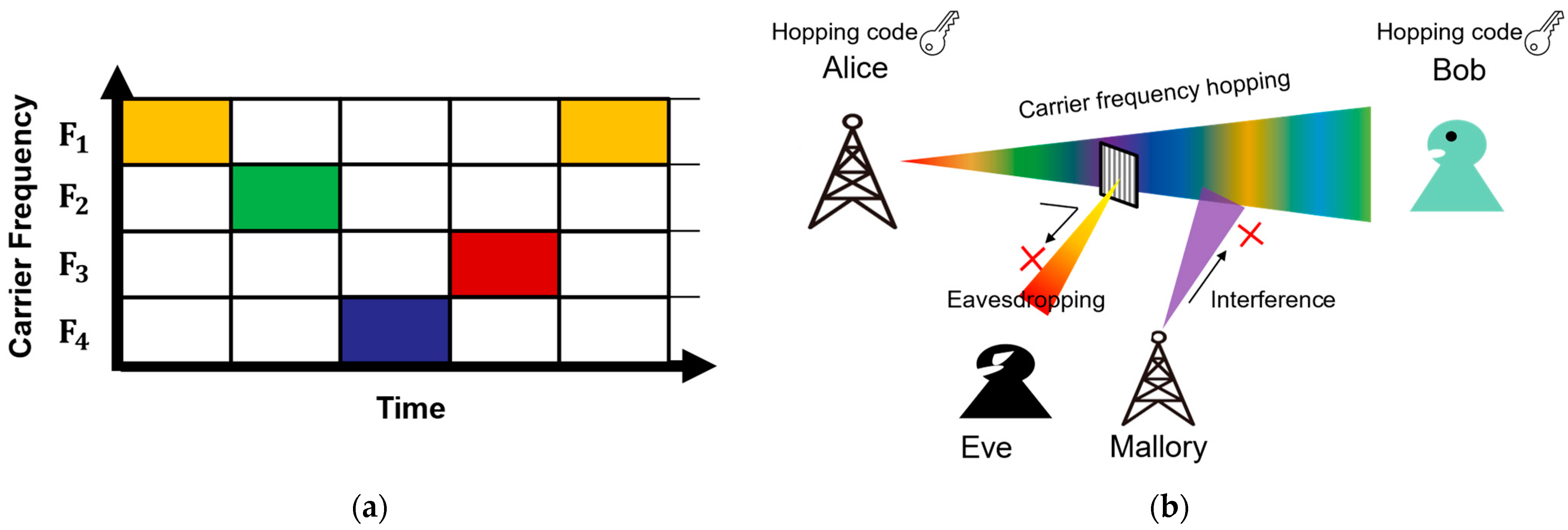
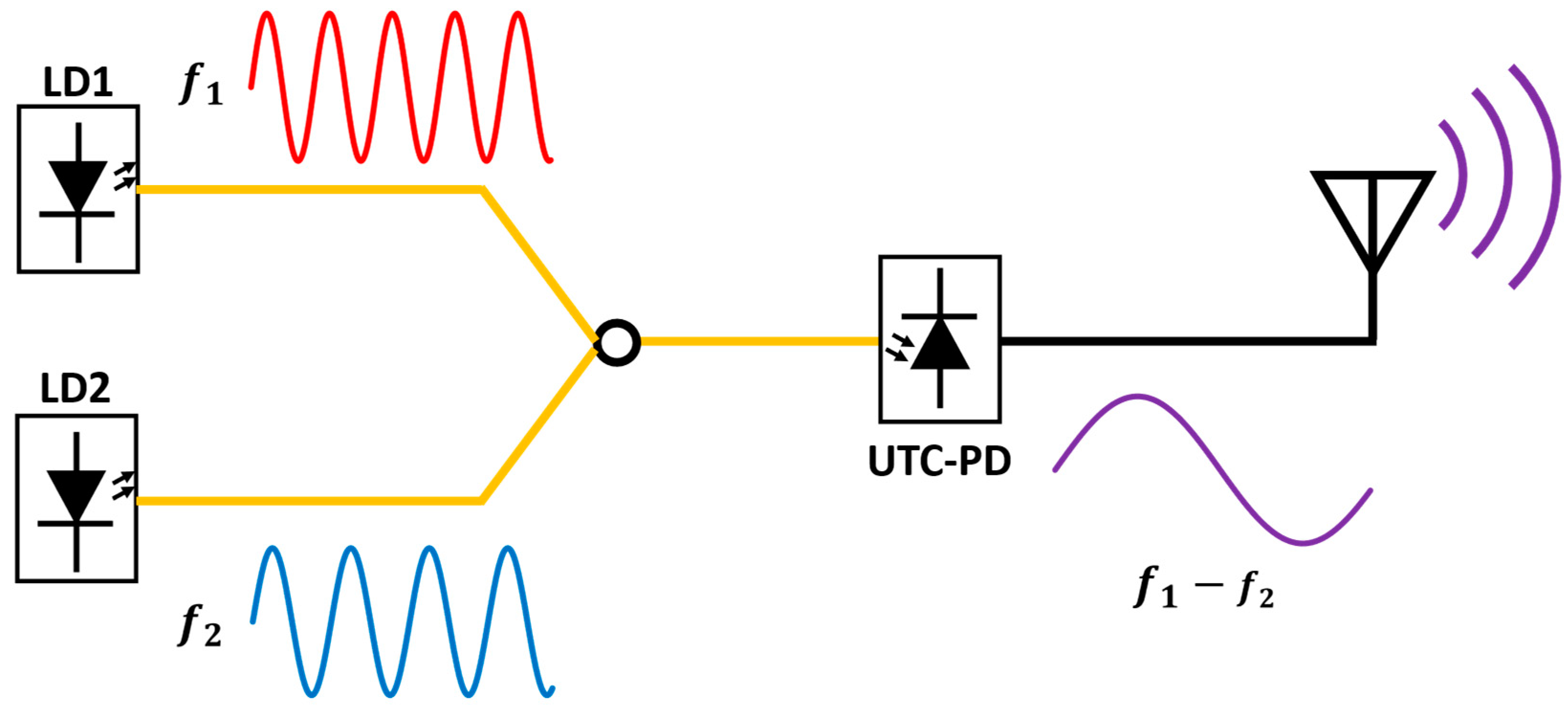
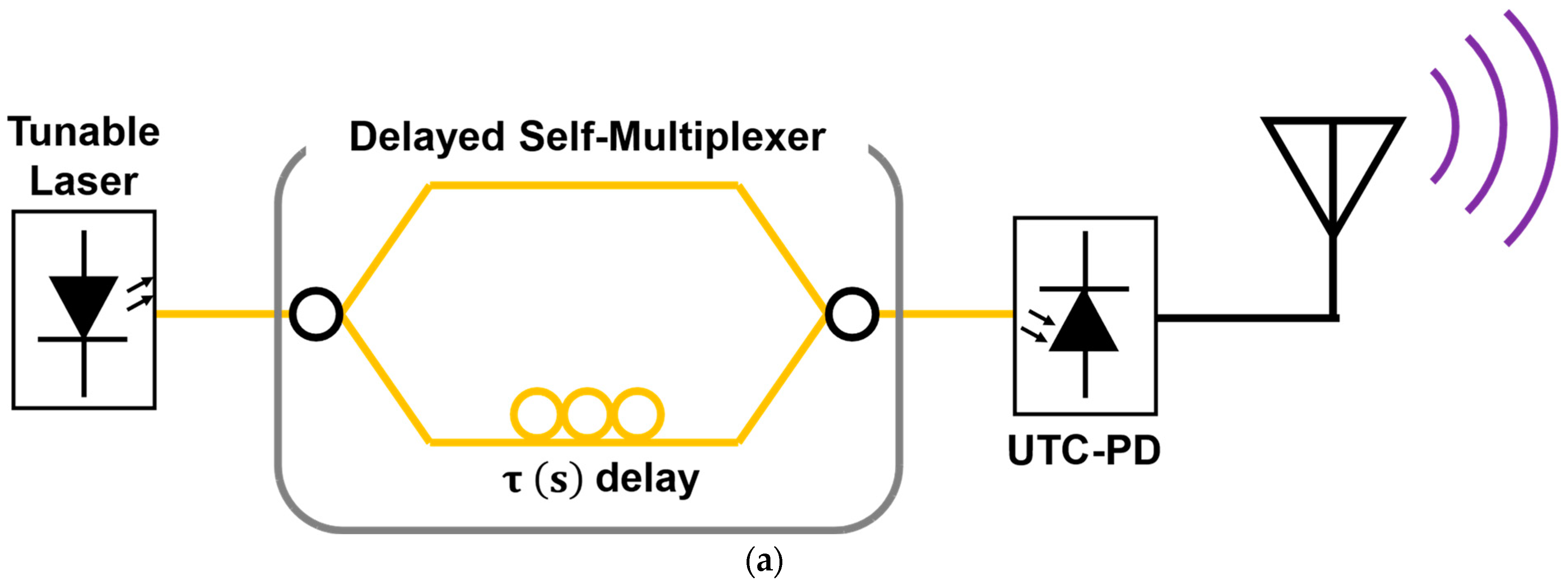
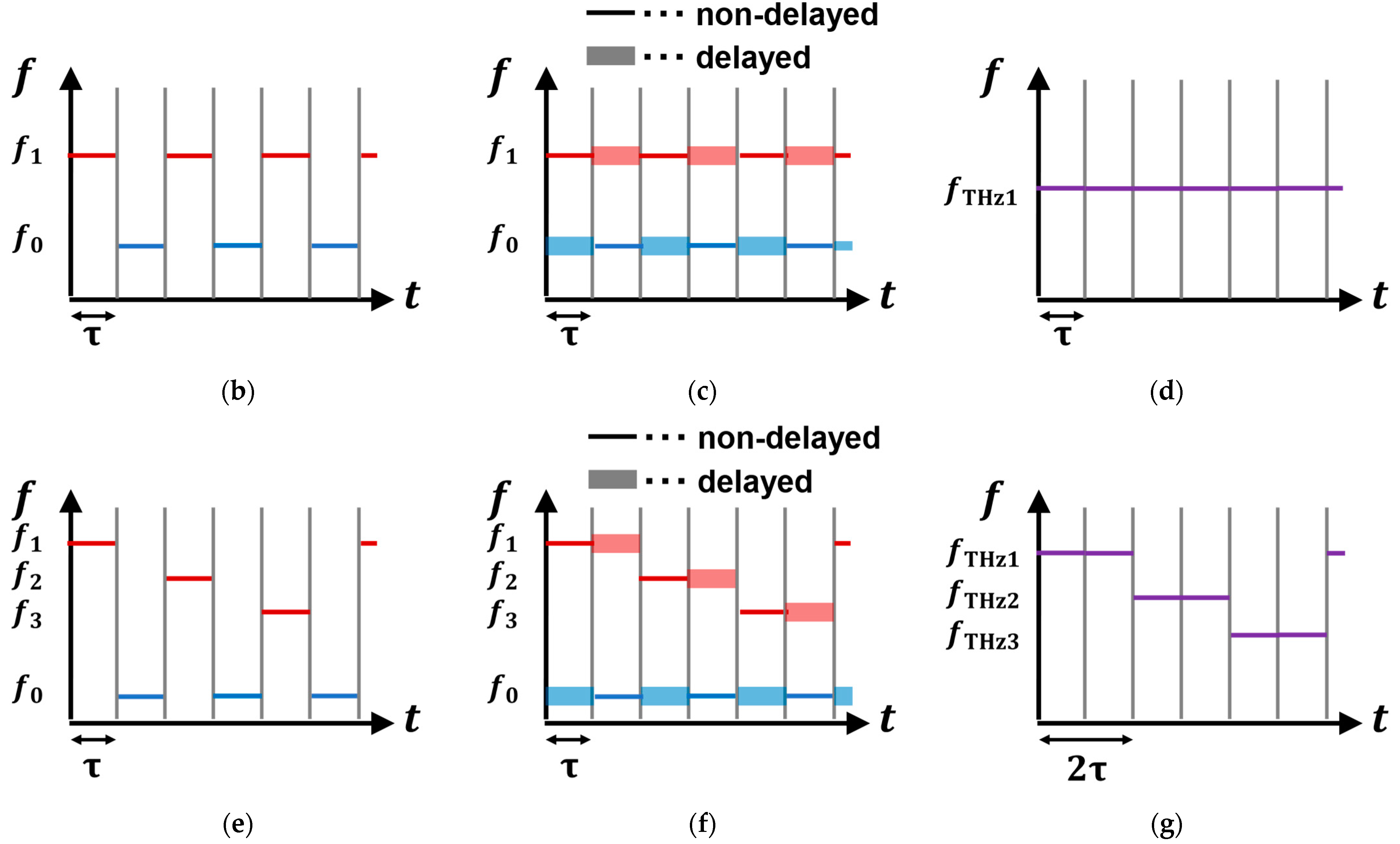

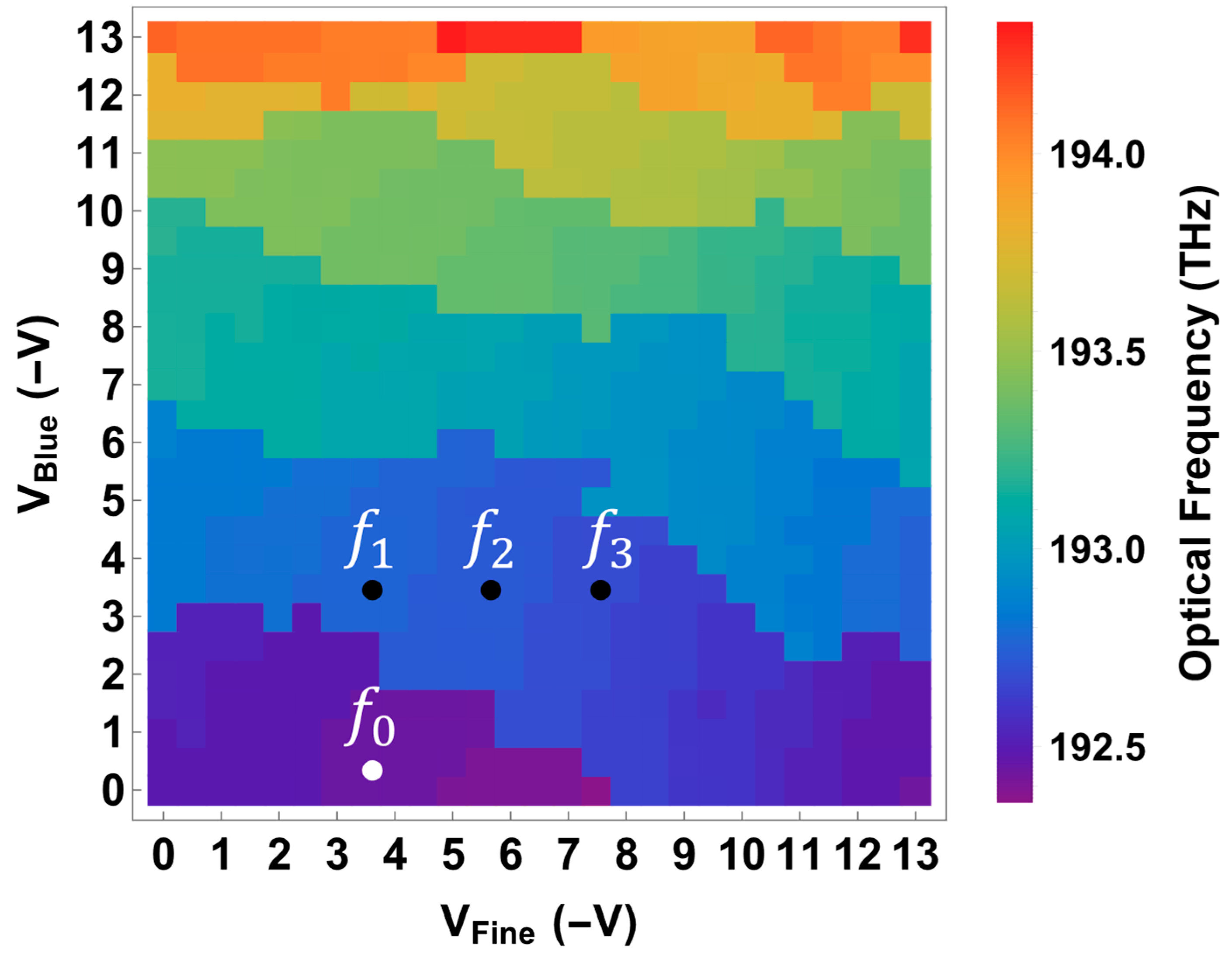



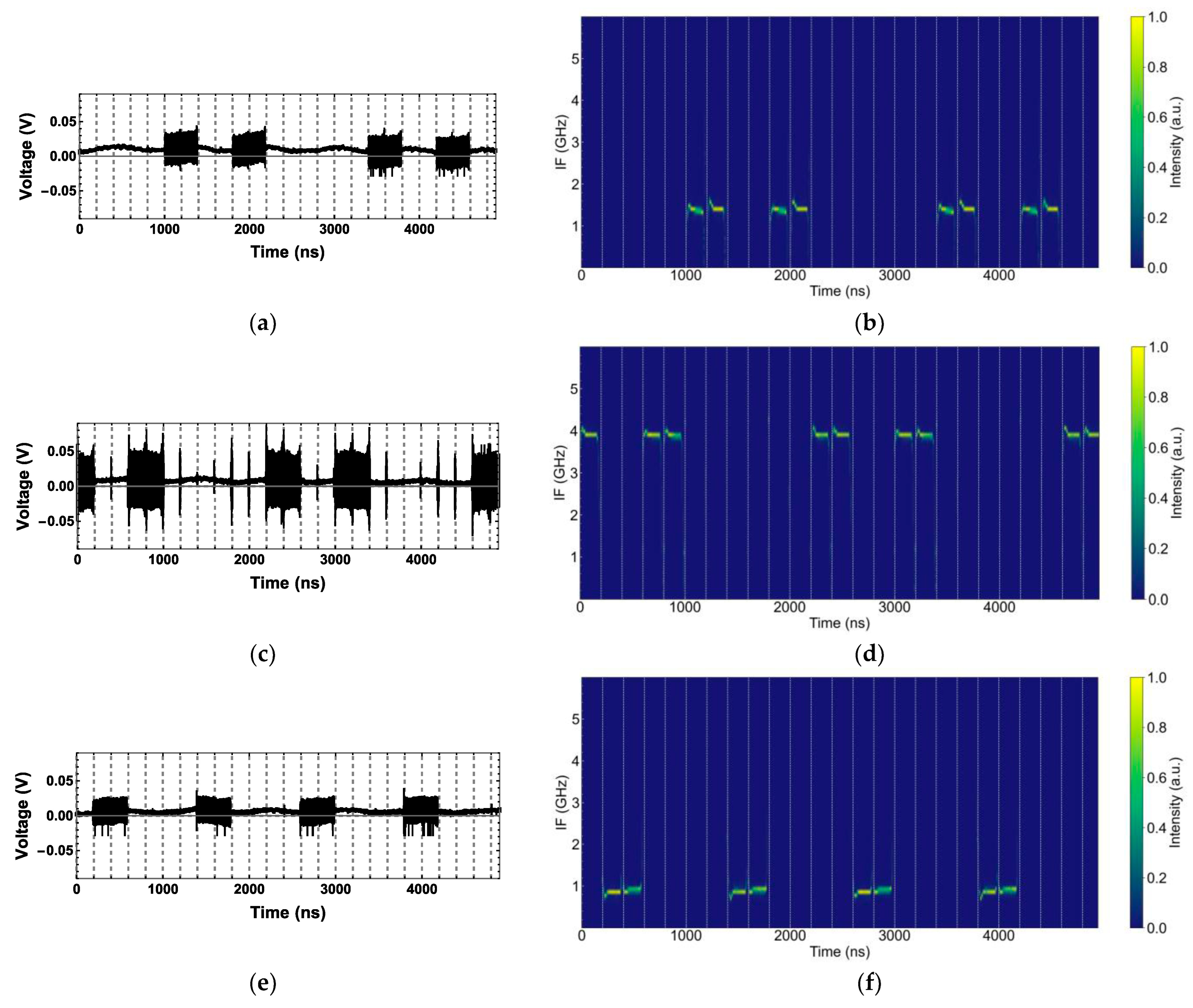
Disclaimer/Publisher’s Note: The statements, opinions and data contained in all publications are solely those of the individual author(s) and contributor(s) and not of MDPI and/or the editor(s). MDPI and/or the editor(s) disclaim responsibility for any injury to people or property resulting from any ideas, methods, instructions or products referred to in the content. |
© 2025 by the authors. Licensee MDPI, Basel, Switzerland. This article is an open access article distributed under the terms and conditions of the Creative Commons Attribution (CC BY) license (https://creativecommons.org/licenses/by/4.0/).
Share and Cite
Masutomi, N.; Ye, S.; Li, B.; Kaide, R.; Che, M.; Mikami, Y.; Ueda, Y.; Kato, K. Cost-Effective and Energy-Efficient Photonics-Based Frequency Hopping by Single Wavelength-Tunable Laser for Secure THz Communication. Photonics 2025, 12, 76. https://doi.org/10.3390/photonics12010076
Masutomi N, Ye S, Li B, Kaide R, Che M, Mikami Y, Ueda Y, Kato K. Cost-Effective and Energy-Efficient Photonics-Based Frequency Hopping by Single Wavelength-Tunable Laser for Secure THz Communication. Photonics. 2025; 12(1):76. https://doi.org/10.3390/photonics12010076
Chicago/Turabian StyleMasutomi, Naoto, Shenghong Ye, Bo Li, Ryota Kaide, Ming Che, Yuya Mikami, Yuta Ueda, and Kazutoshi Kato. 2025. "Cost-Effective and Energy-Efficient Photonics-Based Frequency Hopping by Single Wavelength-Tunable Laser for Secure THz Communication" Photonics 12, no. 1: 76. https://doi.org/10.3390/photonics12010076
APA StyleMasutomi, N., Ye, S., Li, B., Kaide, R., Che, M., Mikami, Y., Ueda, Y., & Kato, K. (2025). Cost-Effective and Energy-Efficient Photonics-Based Frequency Hopping by Single Wavelength-Tunable Laser for Secure THz Communication. Photonics, 12(1), 76. https://doi.org/10.3390/photonics12010076




